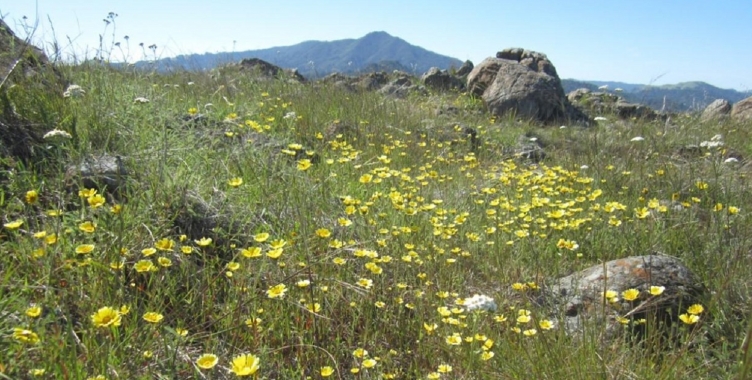
A view of Mt. Tamalpais from my Ring Mt. study site, Marin County, CA
Overview
My research program seeks to understand how small and isolated populations of rare plants persist despite significant ecological and evolutionary challenges. I am especially interested in how population dynamics affect population genetics and vice versa, the conditions under which gene flow promotes adaptation (by increasing genetic diversity) or restricts it (by introducing maladapted alleles), and how we can use this information to improve conservation.
To explore these questions, I study naturally rare plants adapted to stressful serpentine soils. I use a combination of observational and experimental approaches in the field and common garden, demographic and mathematical modeling, and molecular and genomic tools.
All of my projects have a conservation theme at their core. A rapidly changing climate, habitat loss and population fragmentation pose threats to the persistence of numerous species, perhaps especially those already living in extreme environments (e.g., serpentine soil). Our ability to predict how populations will respond to these changes – and we how can intervene to reduce the risk of extinction – hinges on true collaboration between basic and applied scientists. To that end, I work in close collaboration with land managers in Marin County to develop management plans and data collection protocols and am a member of a USFWS Rare Plant Recovery Implementation Team.
My current projects are summarized below:
Variation in mating systems of two rare sister taxa
Variation in mating systems has important consequences for plant populations including reproductive assurance, the expression of inbreeding depression, and the ability to adapt to environmental variation (including climate change). I am currently exploring these ideas using sister taxa with contrasting forms of rarity. Historically Streptanthus glandulosus ssp. niger existed as a single population of hundreds of thousand plants (but was recently fragmented into two much smaller populations) while S. glandulosus ssp. secundus occurs as a few dozen populations, ranging in size from < 20 flowering plants to several thousand, scattered across the whole of Marin County, CA. We are measuring differences in baseline levels of geitonogamy, herkogamy, and dichogamy between the two taxa. Drought, which is predicted to occur more frequently with climate change, has also been shown to alter rates of self-pollination, and we are exploring its effects as well.

Adaptation to a heterogeneous environment
Understanding how genetic variation is distributed within and among populations is crucial for inferring how evolution has operated in the past, and how it might potentially act in the future. In a heterogeneous environment, balancing selection may lead to high genetic diversity within populations and little differentiation among them; alternatively, environmental heterogeneity may lead to local adaptation, resulting in a high degree of genetic differentiation between populations. I am exploring these questions with my collaborators Joe Braasch and Julia Harencar, working with the threatened Calochortus tiburonensis. This species' entire global distribution is a single 50-ha hilltop and while the geographic range is small, the chemical variation of the soil is substantial. We are using RADseq data to quantify genetic variation and describe how it is arranged across the landscape. This work will provide insights into the potential for adaptive evolution as the climate changes and how genetic concerns ought to be addressed in conservation planning.

Local adaptation to a disturbed, anthropogenically-created habitat
Studying local adaptation allows tractable tests of the relative strengths of natural selection and gene flow. I am testing whether the endangered, serpentine endemic Streptanthus glandulosus ssp. niger has become locally adapted to a novel habitat created when subsoil was exposed by the construction of a fire road. This subsoil habitat has distinct characteristics (soil chemistry, water holding capacity, surface temperature, light environment) from undisturbed serpentine grasslands. Early results from common garden and reciprocal transplant experiments in the field support the hypothesis that this endangered species has undergone rapid evolution in ecologically important traits associated with this anthropogenically created habitat, despite high gene flow between plants in this habitat and those in the adjacent undisturbed serpentine grassland. Interestingly, plant density is also higher in the anthropogenic habitat, creating an interesting conservation considerations.
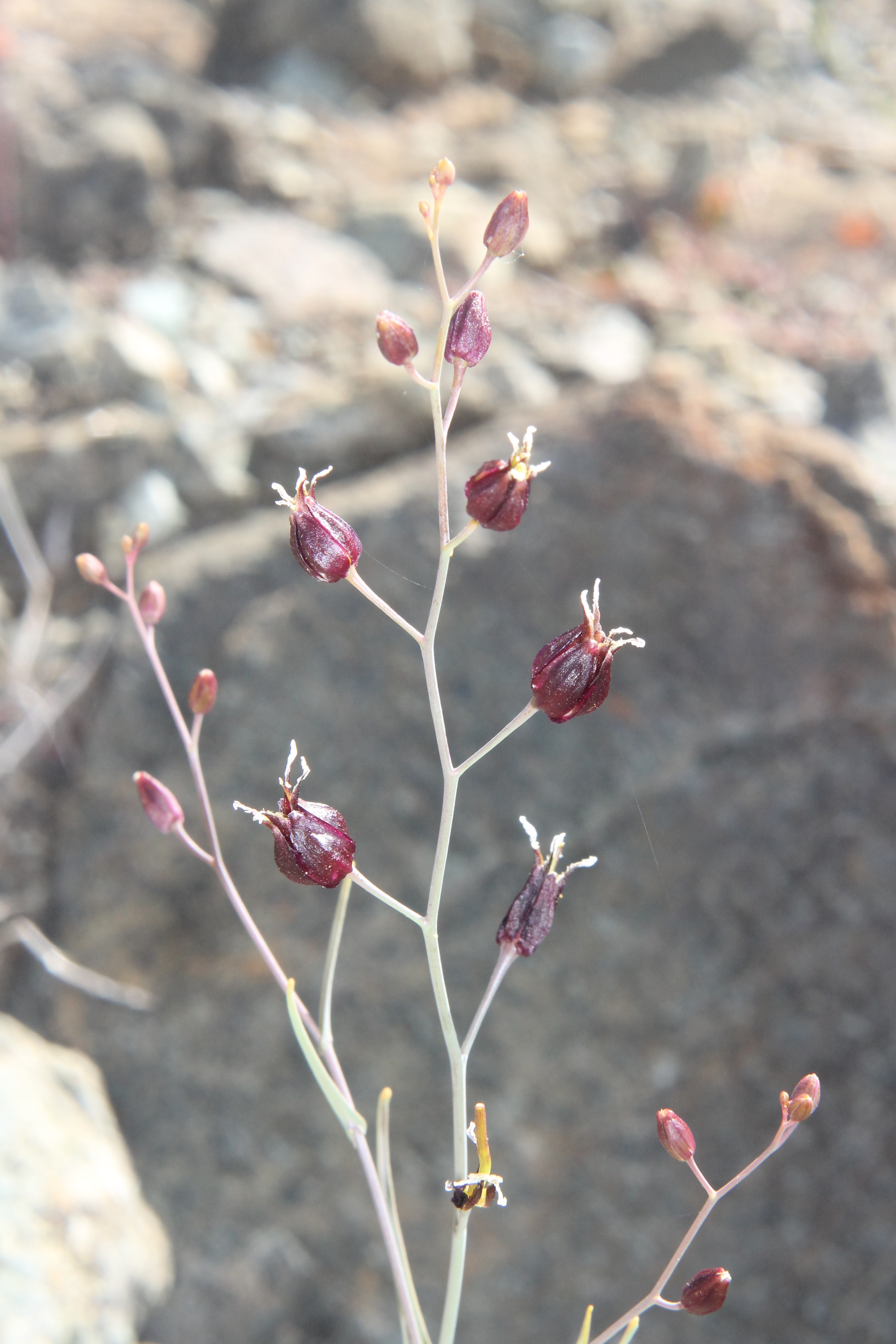
Demographic consequences of rapid trait evolution in the invasive plant Centaurea solstitialis
Centaurea solstitialis (yellow starthistle) is native to Europe and considered to be one of the most problematic invaders in California. Our previous work has shown rapid evolution in this species since its introduction. The invasive genotypes have faster growth rates, earlier flowering time and more capitula per plant compared to European genotypes. Along with collaborators Katrina Dlugosch and David Baltrus, we are using a spatially explicit, individual based simulation model to make projections about whether these trait changes contributed to its success as an invader. Thus far, our data suggest that these novel traits likely led to a faster rate of spread across the landscape and higher population growth rates, but not to increased plant density (funding USDA #2015–67013–23000; NSF #1750280).
Integration of ecological data into monitoring plans
Monitoring is required for all species protected by the Endangered Species Act. However, guidance is rarely provided on how monitoring plans should be designed and implemented or how the data they generate can be used to inform effective conservation. Ideally, monitoring efforts collect data that can be used in simulation models that link population dynamics with management actions (Population Viability Management). In the absence of explicit guidance, managers often employ approaches determined more by practical considerations than by biology. Because of the coarse nature of the data generated, this approach is often able to detect only the most pronounced declines, i.e., a decline so severe that management options are already limited by the time the alarm has been raised. Further, monitoring data cannot identify the proximate cause of a decline nor can they estimate the effect different management actions are expected to have on the population. One solution is the use of demographic modeling. I am joining forces with the resource staff at Marin County Parks to create a new management plan for the threatened plant, Calochortus tiburonensis. We realized the need for this project when we noticed a significant discrepancy between what their monitoring data and my demographic modeling concluded about the status of this species. Our collaborative efffort will increase the efficacy of conservation interventions and minimize the risk of spending scare conservation funds on actions that will not improve population performance or ought to be redirected towards other more imperiled species.

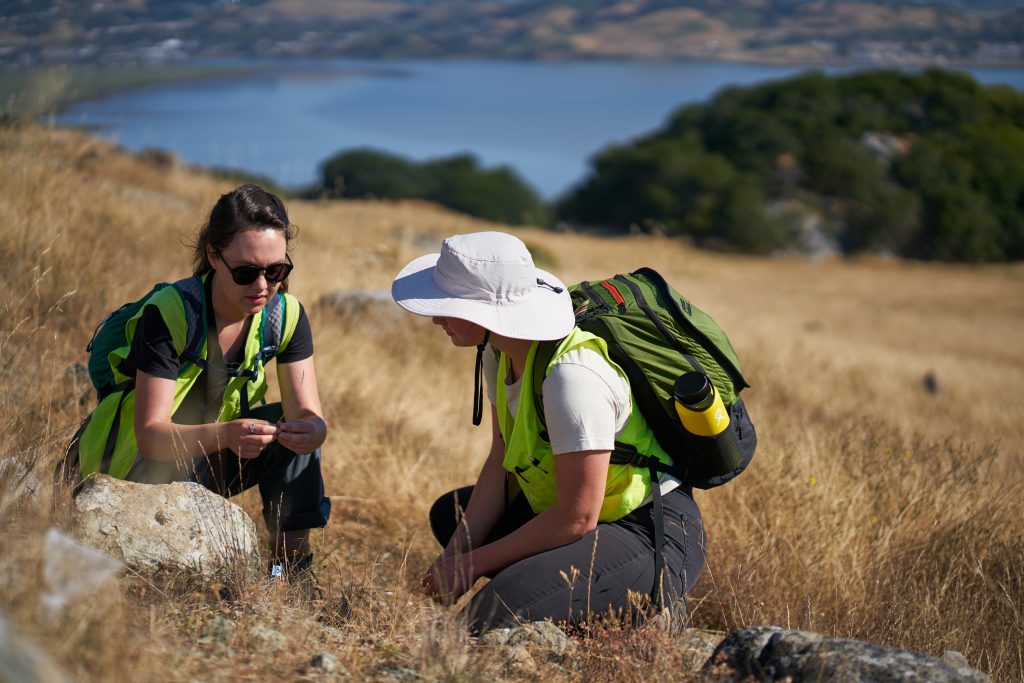
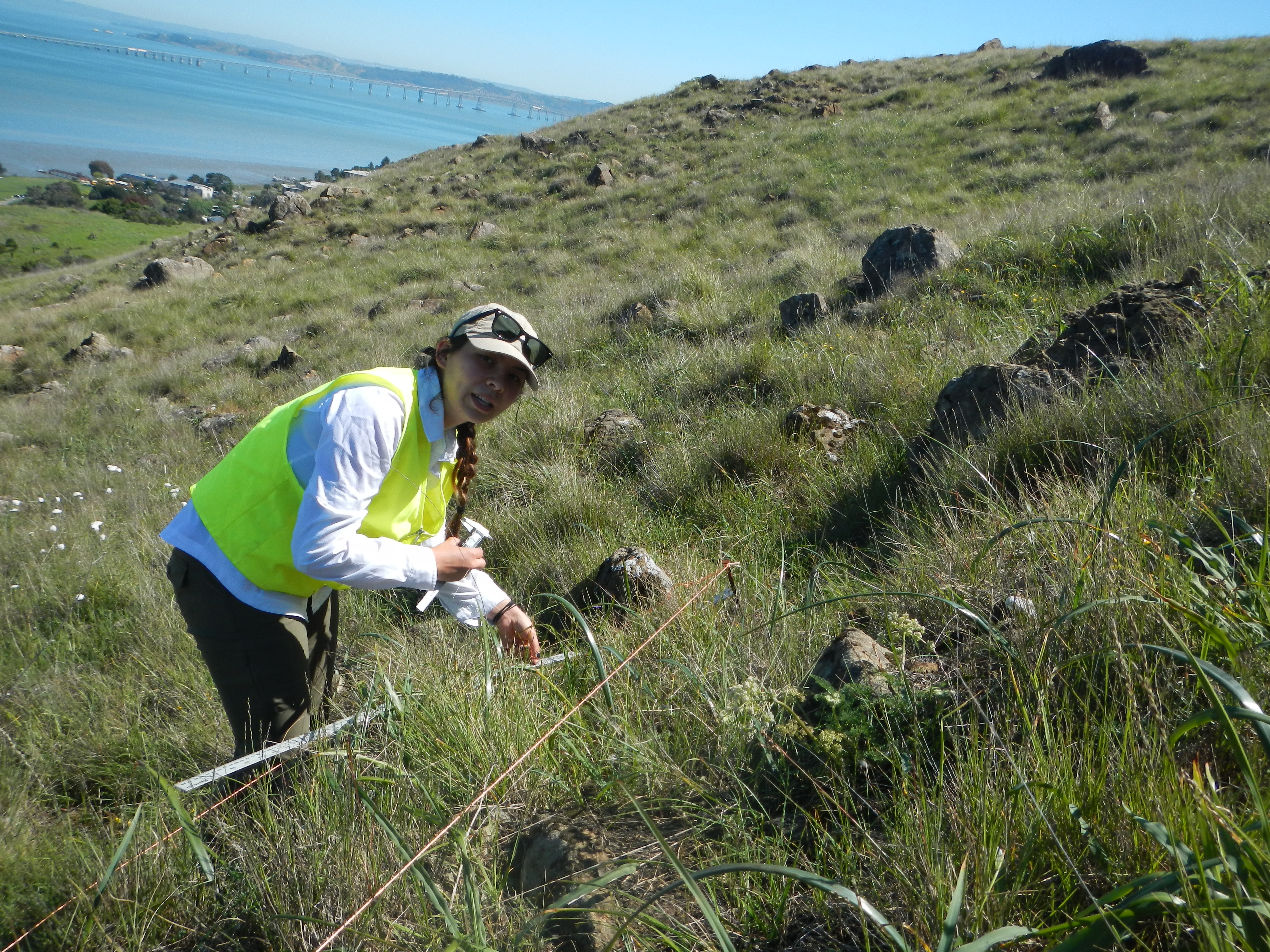
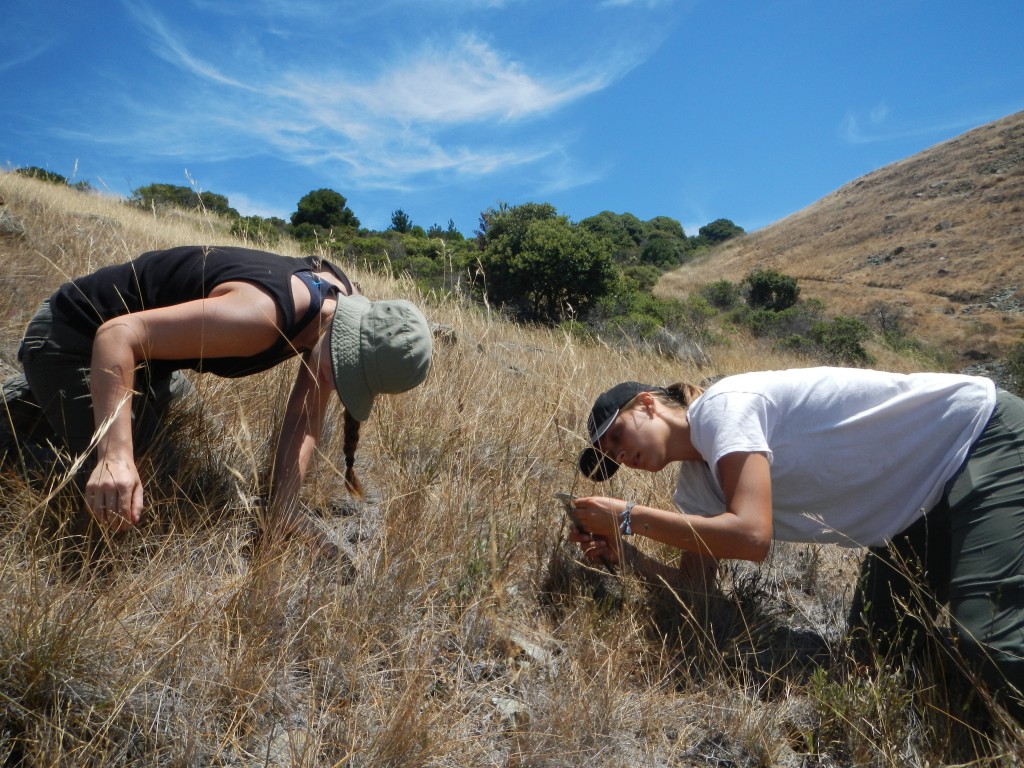
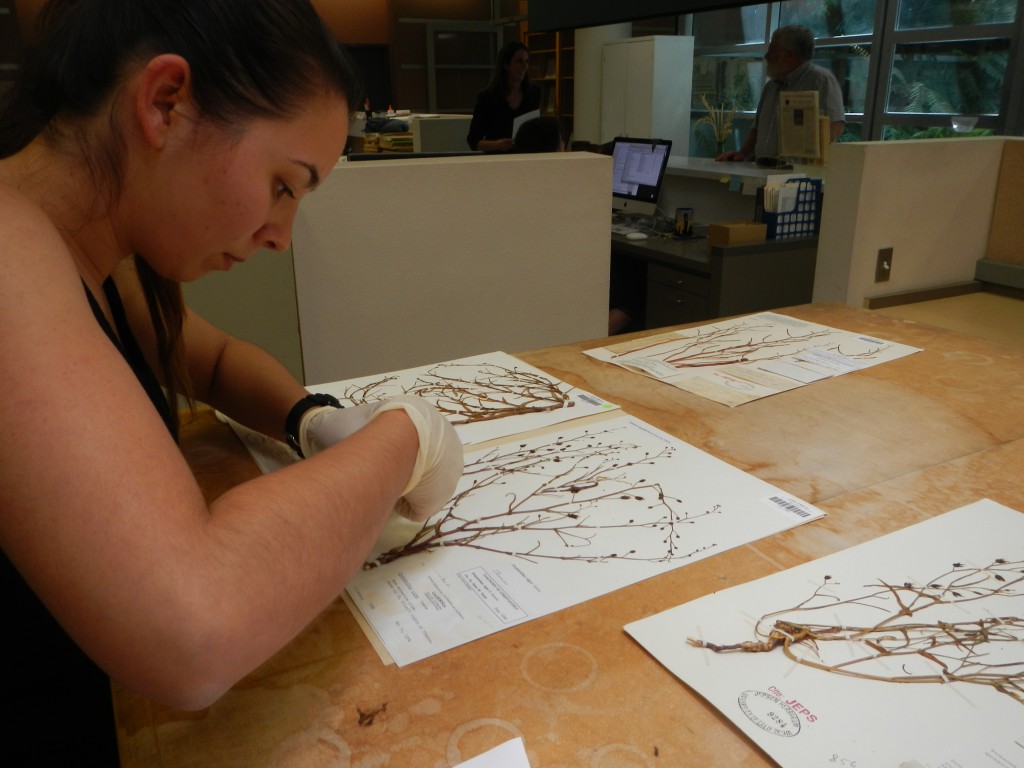
Brittany Burnett in the lab (upper left), Brittany and Hannah Horten (upper right) practicing hand pollinations in the field, Geneva Lee collecting demographic data, Andrea Kuftin and Julia Harencar measuring siliques, and Geneva collecting tissue samples from an S. glandulosus ssp. niger plant collected in 1902 from the Jepson Herbarium to assess historic genetic diversity
Sarah Swope, Mills College, Biology Dept., 5000 MacArthur Blvd., Oakland, CA 94613, sswope AT mills DOT edu